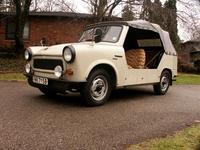1957 Trabant Tramp Roadster "Review" - Better Late Than Never
By Steve Purdy, Detroit Bureau Cheif
Perhaps the most universally disrespected automobile of all time is the Trabant. Produced by Sachsenring, essentially a manufacturing adjunct of the East German Communist government, the Trabi, as it has been affectionately (or teasingly) known, was made from 1957 until the Berlin Wall came down.
Millions of them still smoke up the roads of Eastern Europe, and yearly gatherings of the faithful continue to celebrate the little car. Over three million of the tiny two-cylinder cars were made at the factory in Zwickou where pre-WWII Horch and Auto Union products were made. After the war, with East Germany solidly part of the Communist sphere, production at the factory concentrated on essential trucks and tractors but soon included the little car that could. After all, even Communists wanted and needed personal transportation.
The two-stroke, air-cooled, 26 horsepower engine needs no valve train and has only five internal moving parts. Even though the political environment severely limited the resources that could be put into the design of the Trabant and its siblings these were, after all, German engineers and their product reflects the traditional Teutonic aptitude for making things work.
Though the Trabant engendered much disrespect for being Spartan and smoky, its innovation and durability were admirable. Because steel was expensive and hard to get in East Germany alternative materials were explored with which to produce various parts of the car. Bodies were made of Duraplast, a composite of cotton and other organic fibers bound by a resin - much like fiberglass but more suited to car bodies because it had less tendency to shrink. We could not substantiate the legend that soy bean fibers were used and, because rats liked to chew the bodies, rat poison was incorporated into the product.
Though preceded by other cars the ’57 P50 was the first to be called Trabant. The transverse, front-wheel-drive setup predated the Mini normally credited with pioneering this setup. In ’62 the 500cc engine was enlarged to 601cc resulting in a couple extra horsepower. Not insignificant when one is considering horsepower ratings in the 20s. Unsophisticated to be sure, the Trabi was durable, simple and eminently repairable.
Refinements and upgrades continued but outwardly it looked unchanged. Features such as tab-adjustable headlights, a remarkable engine heat capturing system, and a removable headlight knob to prevent a malicious person from turning your lights on to drain the battery, confirm that the car was German engineered.
The car we discovered in nearby Birmingham, Michigan is a rare ’85 Trabant 601F Tramp convertible owned by engineer, Peter Dawson. He reports that two versions of the convertible were produced, differing only in color. The green ones were for military use, the tan ones for border guards. His, as you can see, is the latter. The front clip is Duraplast but the rest of the body is steel. It still weighs only about 1,400 pounds and gets close to 45 miles per gallon of mixed gasoline and oil.
Be honest now. How many of you dedicated car lovers out there even knew there was such a thing as a Trabant Convertible? Dawson and his wife Julie, an accomplished artist, are world travelers. He reports they’ve spent time in, and explored, 95 countries. While exploring East Germany after the wall came down they visited the old Trabant factory at Zwickou, now a museum, where the Trabant intrigued them. Upon returning home they purchased one, a sedan, from a South Carolina collector. Later they sold the sedan and found this unusual convertible in an Ohio collection that was being sold off. Dawson was thrilled to think he was getting one with only 7,000 miles on it, but found when he got it home that it really had 700 miles on the odometer.
I visited on a brisk winter day with roads dry and salt free. After a warm indoor chat we went for a ride. Dawson folded his tall, lanky frame into the drivers seat much more easily than I squeezed my portly one into the passenger seat. Although designed to fit four adults, a fifth could be sandwiched in if rear seat passengers aren’t too wide. We didn’t bother with the side curtains.
The starter energetically turned the little engine over as it sputtered confidently to life sounding much like a popcorn popper. After a couple of stalls it settled into a chattering idle. The stubby 4-speed column shifter was stiff from the cold but Dawson adeptly limbered it up with a bit of expert manipulation. The odd, up-side-down shift pattern is mapped on a sticker inside the windshield. Jouncing stiffly out the driveway we buzzed around the block to get the feel of the simple machine. Driver and passenger are not isolated from the road or the elements making for a distinctly sports-car-like feel. Certainly the handling is a bit more like a car of the thirties.
The 13-inch wheels hide small drum brakes that are perfectly adequate for the job. Since the car is so small and light stopping power is not a big issue. Fourth gear, however, includes a free wheeling function so long, steep, down-the-mountain runs might get a bit dicey. Fortunately, we had only a short down hill roll into the valley of a Rouge River tributary with which to contend.
The Dawsons use the Trabi Tramp just to buzz around their suburban community and they have driven it in the legendary Woodward Dream Cruise. Unlike its European owners they wouldn’t attempt a long drive in the little bugger but it’s great fun to take to the coffee shop. And, really, it only smokes until it’s well warmed up.
For More Just Google Trabant below



